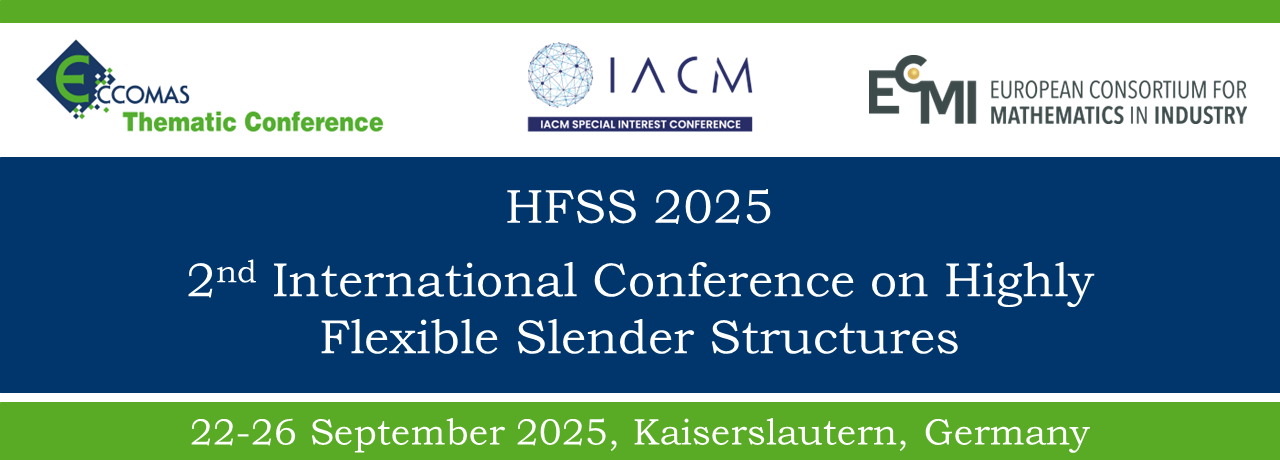The distinctive focus of the conference is on structural systems and its parts or elements which are both (i) highly flexible, i.e. exposed to large overall structural deformation and (ii) slender, i.e. characterised by a geometry with at least one structural dimension considerably smaller than the other two as in the case of non-linear rod and shell models.
The highly successful 1st edition of this conference (HFSS 2023, 25 – 29 September 2023, Rijeka) took place during the closing stage of an MSCA Innovative Training Network on highly flexible slender structures for industrial applications (THREAD). The 2nd edition of this conference likewise addresses open questions specific to such structures and extends the scope of the 1st conference:
- How can the internal physical behaviour of a slender structure with a complex cross-section, e.g. multi-fibre and composite, be captured by a 1D model?
- How can the resulting highly nonlinear problem be discretised in space and time without destroying its mathematical structure and symmetries?
- How can the models and solvers account for complex mechanical interactions in systems composed of many constituents on the mesoscopic level (fibres, wires, platelets, …) interacting with their environment?
- How can the computational performance, especially for flexible surface-like parts or large systems of slender structures, be substantially improved?
- How can the structural models be validated experimentally for large structural deformations?
The conference aims to attract wider research community working in the areas of mechanical modelling, mathematical formulations and numerical methods for highly flexible slender structures. Specifically, it is open to both engineers and mathematicians brought together around major challenges in theoretical and numerical analysis as well as industrial applications and open-source simulation software development for such structures. The topics of interest involve advanced concepts in experimental and theoretical structural mechanics, contact problems and non-smooth dynamics, computational geometry, discretisation methods and geometric numerical integration including the newest advances in numerical formulations on non-linear manifolds, which will help usher the next generation of virtual prototyping. It is expected that the conference will attract the interest of renowned experts and their teams working in these areas.
Laboratory and virtual experiments aimed at understanding the mechanical behaviour of complex flexible slender structures make one of the key areas of research to which the conference will be devoted. Multi-filament cables, multi-wired harnesses, taut stranded wires or composite beams, woven or non-woven textiles, on the mesoscopic and macroscopic level should be investigated, with the aim to design cross-sectional stress-resultant models capable of capturing the observed constitutive laws. Another one is cutting-edge and geometrically consistent spatial discretisation schemes, as well as modelling interactions between the slender structures themselves and with their environment in operating conditions including frictional contact effects. System-level simulation methods and geometric time integration algorithms able to deal with dynamic interactions between many flexible slender elements and their environment in large-scale models while respecting and preserving the non-linear mathematical structure of the problem, involving also those defined on Lie groups, are of particular interest.
Scientific/technical areas covered
- Experimental mechanics for slender flexible structures
- Constitutive modelling of complex composite cross-sections (e.g. multi-filament or composite slender structures, woven or non-woven textiles etc.)
- Physical and virtual experimentation and mesoscopic simulation models (including those conducted in large-deformation elastic and inelastic regime) aimed at designing efficient stress-resultant constitutive models
- Advanced geometrical formulations and numerical discretisation of slender structures (e.g. local frame/Lie group approaches for spatial discretisation, local-frame methods, arbitrary Lagrangian-Eulerian formulation etc.)
- Contact mechanics in systems involving slender structures (e.g. frictional contact in multi-wire cables and composite beams)
- Mathematical modelling and development of novel numerical algorithms for non-linear dynamic analysis on non-linear manifolds including large-scale models involving complex constitutive laws and those with internal and external constraints
- Geometric integration of equations of motion including fundamental research in the fields of Lie group time integrators, energy-momentum methods and variational integrators aimed at preserving geometric structure and key invariants and guaranteeing convergence and stability
- Adaptive discretisation methods and model-order reduction methods aimed at improving computational efficiency and enabling real-time simulation
- Application of the simulation methods to industrial problems for virtual product development, parameter identification and real-time simulation
- Physics based simulation models of highly flexible slender structures in computer graphics
- Novel formulations of slender structural models in between rods and shells
- Axially moving slender structures
- Configurational forces in slender structures
Mini-symposia
The above topics will be grouped in mini-symposia or presented as a part of the general programme. For this conference, we welcome mini-symposium proposals related to the scope of the conference. More information regarding the call for mini-symposia will be available soon.
